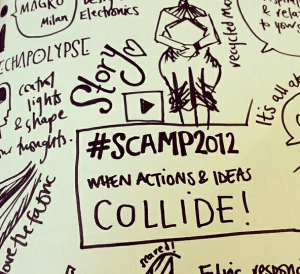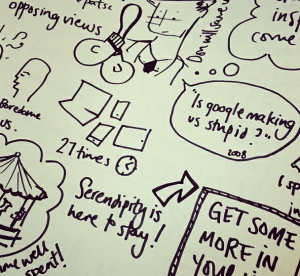Brands
Lessons from Scamp: Create, Play Games, Connect, Tell the Story
The UK ad world is blessed with vivid slang.
A top favorite: “scamp,” which means “doing doodles and writing on napkins and things like that,” explained Ale Lariu, founder of SheSays, a global network of 4,000 women creatives and marketers that looks to take some big ideas off cocktail napkins and into an open forum.

Billed as “a conference about ideas still in progress,” Scamp has been bringing new thoughts and prototypes to London for the past three years. The June 15 event was the inaugural New York conference.
In the airy white-walled sanctuary of midtown’s Art Directors Club, stylish women and a scattering of men gathered on Friday to find inspiration and make connections. Lariu, MC for the day, kept strict time.
“The speakers are just going to come in and start throwing things at you,” she said. “Like ‘bang bang bang bang!’”
The projectiles that landed:
Experiment with Identity
Anna Akbari, entrepreneur and NYU professor, opened the conference by tackling the pressure-filled question, “What do you do?”
Using her own life as an example, she recognized the difficulty of keeping track of multiple identities, especially in an age when we’re creating and curating ourselves online. Though people expect authenticity, she remarked, “It’s very problematic and thrown around as if we all understand it and think it’s great.”
“If you’re not believable to your audience, then your substance is not really going to register,” she said.
But how can we manage our “authenticity” when, while sitting in a conference in New York, our images and identities are working for or against us on multiple channels and various platforms across the world? The answer for some is “virtual suicide” — simply logging off or deactivating a Facebook or Twitter account.
But Akbari presented other practical solutions. One was “Orienting the Compass,” or deciding on a place of comfort, a home from which to create and explore. The rest of her solutions mostly focused on intention, recognizing that identity is fluid, creativity trumps biography, and authenticity is irrelevant. Especially as we move between physical and virtual worlds, Akbari advocates a continued search for identity, knowing the “real self” will never be found.
Here she quoted polish writer Slawomir Mrozek: “It’s smashing fun on condition that the real self will never be found. Because if it were, the fun would end.”
Create Constructive Community
Ben Dyett told the story of discussing the future of workspaces at a dinner party, someone said, “Hmm…business as usual is how business is done.” He said he was upset to hear that. “This is the kind of thing that’s going to crush your passion and keep you really small,” he reflected. So how could he help people move beyond doing things “as usual”?
 At the time, Ben was a legal consultant with no physical place to work during the day. He wanted more community. So, with co-founders Karina Warshaw and Stuart Warshaw, he created Grind, a fluid coworking space. Given the recent “freelance surge,” Grind is a welcome addition to previous cubicle and office-sharing options for consultants and freelancers.
At the time, Ben was a legal consultant with no physical place to work during the day. He wanted more community. So, with co-founders Karina Warshaw and Stuart Warshaw, he created Grind, a fluid coworking space. Given the recent “freelance surge,” Grind is a welcome addition to previous cubicle and office-sharing options for consultants and freelancers.
More than a space, Grind connects its members through word of mouth as well as a digital network. As soon as someone checks in for the day, their online profile will move to the top of the network so fellow Grindists know who’s in the office and who they can easily contact. Grind occupies one office in Manhattan but is looking at real estate in Los Angeles and Berlin, among other cities.
Focus Groups Are Dumb
Farrah Bostic, former researcher and blogger at PLH, sees a broken system. She began her presentation with a list of focus group mistakes: target segments, facilities, the mirror, discussion guides, and transcripts are all dumb. “Facilities are not real places,” she said bluntly. “The mirror makes you treat those people like caged animals or reality TV stars.”
Focus groups are meant to inform brands and businesses on people’s preferences, but in overly manipulated environments, they fail. “We’ve decided to make research sciencey,” Bostic said. “And in the process, we’ve sacrificed reality.”
Instead, Bostic suggests increasing playfulness and thus productivity. Watch people play, let them solve puzzles. Have researchers in the room, really witnessing a group’s emotions and interactions. Recruit groups of people who will compete with each other, and start talking to brand rejecters. Instigate games.
“Games are just this ancient form of communication and collaboration between people,” Bostic said. By implementing them in focused ways, games can help research groups understand how people interact.
Develop a Character, and then a Brand
“What is a brand really?” Julie Cottineau asked. It’s not a name, logo or ad.
 “A great brand is a story well told,” she said. “When you look at other founders out there, they have a very personal story that they tell over and over again that connects to their brand.”
“A great brand is a story well told,” she said. “When you look at other founders out there, they have a very personal story that they tell over and over again that connects to their brand.”
Former VP of Virgin, Cottineau now runs her own consultancy, BrandTwist.
When teaching entrepreneurs and corporations how to build their brands, she first advises them to define their audience, to develop a “bull’s eye target.” Who do you want to buy your product or participate in your program? Then, she helps her clients really get to know this character. What do they eat for breakfast, what apps do they use most often? For instance, Old Spice realized women buy deodorant, so they began their infamous campaign directed towards many women’s far-fetched fantasies.
Cottineau titled her presentation “A Strong Brand Is An Entrepreneurs’ Secret Weapon.” Whether that means defining one’s own style (Cottineau wears purple for all her BrandTwist presentations) or starting a branded charitable campaign, every organization can benefit from knowing their audience and using story to establish a clear identity.
If the Scamp crowd takes that to heart, we may begin to see some truly innovative marketing.
Get better at your job right now.
Read our monthly newsletter to master content marketing. It’s made for marketers, creators, and everyone in between.




